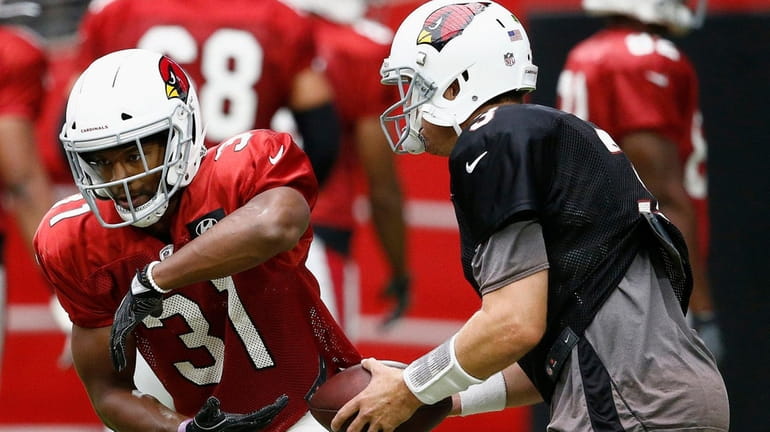Football 101: Basic football terminology

Arizona Cardinals quarterback Carson Palmer, right, fakes a handoff to running back David Johnson during training camp on July 29, 2017, in Glendale, Ariz. The fake handoff is a key part of play action. Credit: AP / Ross D. Franklin
What’s the difference between a Cover 2 and a Cover 4 defense? When a TV announcer says a player takes a trap run from a pistol formation into the second level, what exactly do they mean? Learn some of the basic inside football terminology with our Football 101.
Ace formation: Also known as the “singleback formation,” in which one running back lines up about five yards behind the quarterback.
Box: The area between the offensive tackles, about five yards deep, which encompasses the defensive linemen and linebackers.
Catch radius: How far a player can extend their arms, in any direction, to catch a ball.
Checkdown: A route run closer to the line of scrimmage, usually by a running back or slot receiver, that serves as a safety net for the quarterback in case nobody is open downfield.
Counter run: A misdirection run play in which the running back takes his first step in one direction, then cuts to the other direction to take the handoff.
Cover 0, Cover 1, Cover 2, Cover 3, Cover 4: Zone coverage schemes. The number indicates how many defensive backs are dropping back into deep coverage, with the other defensive backs blitzing or playing man-to-man coverage:
— Cover 0 essentially is pure man-to-man coverage with nobody dropping back into deep coverage.
— Cover 1 means one safety drops back into deep coverage.
— Cover 2 means both safeties drop back into deep coverage.
— Cover 3 means one safety and two cornerbacks drop back into deep coverage.
— Cover 4 means two safeties and two cornerbacks drop back into deep coverage. It’s often called “quarters” defense because each defensive back covers one-quarter of the deep field.
Cut block: A block in which the offensive lineman dives at the defender’s knees, cutting the defender’s legs out from underneath him. This kind of block often is considered dirty because it can lead to serious injury.
Defensive fronts (3-4, 4-3): A 3-4 defense uses three down linemen and four linebackers, while a 4-3 has four linemen and three linebackers.
Dime defense: A dime defense features six defensive backs.
Draw: A type of run play in which the quarterback pretends to pass before handing off to the running back.
Fair catch: During a kick or punt return, the returner can wave his hand in the air before receiving the ball to signal for a fair catch. The returner then cannot advance the ball and catching it, and the kicking team cannot interfere with him.
Gunner: On kick and punt returns, this is a player who lines up near the sideline and is tasked with getting upfield as quickly as possible to take down the returner and/or recover a muffed kick.
Hard count: On offense, when a quarterback puts a louder, more inflected accent on his regular snap count in an attempt to draw overly aggressive defenders offsides.
Iso run: A run play, from an I-formation, in which the running back follows his fullback up the middle between the center and either guard. It is called “iso” because, if executed correctly, the fullback will be able to isolate one of the linebackers for a one-on-one block.
Jumbo package: A formation with three tight ends, two running backs and no wide receivers. It is often seen in short-yardage and goal-line situations.
Nickel defense: A nickel defense features five defensive backs. The extra defensive back is caled the “nickelback.”
Off coverage: When a cornerback allows between seven and 10 yards of cushion to his receiver, usually to prevent deep plays downfield.
Pancake: When a blocker knocks his defender to the ground, leaving him “flat as a pancake.”
Pistol formation: An offensive formation in which the quarterback lines up about four yards behind center (not as far back as in shotgun) and the running back lines up three yards behind the QB.
Play action: When a quarterback fakes a handoff to a running back and then looks to pass.
Pooch kick/punt: A kick or punt which focuses on higher hangtime but shorter distance. This often is used to pin a receiving team deep within its own territory or to prevent a big return by forcing the returner to call a fair catch.
Press coverage: Often called “bump and run,” this is when a cornerback lines up about a yard away from his receiver, usually to jam him at the line and disrupt the timing of the route.
Prevent defense: A prevent defense features at least five defensive backs, all dropping back into deep coverage. This scheme, often deployed by teams that are up big in the final minutes of a game, is used to prevent deep passes but allows for shorter gains that keep the clock running.
Read-option: A type of run play in which the quarterback reads the outside defender after taking the snap and, depending on what he sees, can hand it off to a running back, run it himself or look to pass.
Route tree: The route tree is a way to boil down the basic routes into a 1-9 number scheme. These numbers often are used when calling a play.
— A “1” route is a flat route, a quick-hitting pattern in which the receiver takes three steps and breaks out toward the sideline.
— A “2” route is a slant route, a quick-hitting pattern in which the receiver takes three steps and breaks into the middle of the field.
— A “3” route is a comeback route, a timing pattern in which the receiver runs straight ahead and turns around towards the sideline for the catch.
— A “4” route is a curl route, a timing pattern in which the receiver runs straight ahead and turns around toward the quarterback for the catch.
— A “5” route is an out route, a mid-to-deep pattern in which the receiver cuts 90 degrees to the sideline midway through the route.
— A “6” route is an in route, a mid-to-deep pattern in which the receiver cuts 90 degrees to the middle of the field midway through the route.
— A “7” route is a corner route, a deep pattern in which the receiver cuts at a 45-degree angle toward the sideline midway through the route.
— A “8” route is a post route, a deep pattern in which the receiver cuts at a 45-degree angle toward the middle of the field midway through the route.
— A “9” route is a go route, a deep pattern in which the receiver simply runs in a straight line downfield.
Second level: The second level refers to the area on defense behind the linemen where the linebackers usually reside.
Silent count: A silent count is when an offense uses visual cues (ex: a leg kick, gesture or physical touch from one lineman to another) instead of verbal cues to communicate when to snap the ball. Road teams often use silent counts in noisy stadiums.
Squib kick: A type of kickoff in which the kicker sends the ball short and low so that it bounces along the ground. The goal is to force one of the slower members of the return team to return the ball.
Strong side: The strong side of a formation is whichever side the tight end lines up on, or whichever side of the formation has more offensive players.
Sweep: A run play in which the quarterback tosses the ball back to the running back, who is running toward the sideline.
Trap run: A run play in which a blocker from the backside of the play comes around to block a defender on the side that the play is going toward.
Trips formation: A formation in which three receivers line up on the same side of the field.
Weak side: The weak side of a formation is whichever side the tight end does not line up on, or whichever side of the formation has fewer offensive players.
Wildcat formation: A special formation in which a non-quarterback lines up at quarterback and takes the snap. Often times, this leads to some sort of run, though the formation does allow for trick plays.
Zone run: A run scheme in which the offensive linemen determine if they are “covered” (have someone directly in front of them to block) or “uncovered” (don’t have someone directly in front of them). If a lineman is “uncovered,” they will help double-team the nearest defender on the side the play is going, then one of them will move up to the second level to block a linebacker as the play unfolds.

